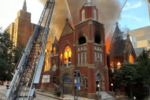For Kevin Monk, life was near perfect as a youngster growing up in Los Angeles. He was the shining star of Little League baseball in his community and had high hopes of one day playing in the majors. His father was a Baptist preacher, his mother a committed believer.
But it wasn’t long before life threw the boy a curve ball. His father became an alcoholic after a work-related accident in 1971 left him crippled and embittered. His brother was brutally murdered in 1978. Despite the desperate prayers of his mother, Monk, at age 13, did what more than a half million young people in the United States are doing today–he joined a gang.
“By the time I was in eighth grade, I was carrying a pistol,” Monk says of his early years as an “OG”–an Original Gangster in the 83rd Hoover Crips Gang. “I was a perfect candidate because I had the devastation that pushes a young man into a gang: traumatic death, hopelessness and an abusive, absent father.”
When he was 17, Monk was drafted by the L.A. Dodgers and later the Milwaukee Brewers, but he never donned the uniform of either baseball team. He instead had become a gang member, or “gangbanger,” who sold drugs and had a cocaine addiction that would nearly take his life.
Today, at 39, Monk is a survivor. He no longer is addicted to cocaine and did not die young–despite being shot six times. There are others like him, some of them less fortunate.
Even those trying to leave the gang lifestyle are sometimes swept into the stories of tragedy. Several years ago police cruisers sped down 50th Street N.E. in the nation’s capital escorting an ambulance en route to an area hospital. Inside, wounded, was an ex-gangbanger who’d become a churchgoer, who had fallen prey to local gang violence.
In cities large and small across America, gang culture has been steadily on the rise since the 1960s. No state is exempt. From the high-rise shores of Miami to the low-rider streets of Los Angeles–the city of origin for black gangs in the United States–the groups have spread across this country and even into foreign ones.
According to the U.S. Department of Justice, some 750,000 youth are members of gangs in America. One-third of them are under the age of 18. Although 90 percent of members are young men, young women have been forming gangs and the numbers of their groups are rising, the Justice Department reported.
Gang activity is so widespread, in fact, that President Bush unveiled plans for an anti-gang task force during his annual State of the Union address in January. The president committed to a three-year, $150 million initiative that will target America’s youth.
Black religious leaders met with the president at the White House in January to discuss problems that place young people at risk of not succeeding in life. One outgrowth of the meeting is the president’s anti-gang initiative, which recognizes existing organizations such as Think Detroit, a nonprofit coaching and mentorship program designed to instill character in Detroit’s youth. The program includes leadership training and a massive sports program that has some 650 volunteer coaches.
“Forty percent of ninth- and 10th-graders in Detroit drop out of school,” says Michael Tenbucsh, CEO. “We keep kids engaged in life.”
Finding solutions to the gang epidemic has proved a daunting task for lawmakers and civic leaders in communities across the country. The challenge is rarely less difficult for the churches of those communities. Some Christian leaders, however, are reaching out to gangbangers right where they live and seeing the power of God
change at-risk and impressionable young people.
Reaching Gangsters
When an eager preacher named Ron Hill opened Love and Unity Church of God in Christ in Compton, California, in 1981, federal assistance for his ministry vision wasn’t available. Hill knew God was leading him to Compton–a city in greater Los Angeles–in search of affordable property he could purchase for a place of worship.
The pastor scraped together money to buy an abandoned nightclub. Vying for souls was nothing unusual for the youthful Hill, but he didn’t realize at first that God had planted his congregation in the middle of turf controlled by the infamous Santa Crips Gang.
“Gang members would come on church property to try and recruit new members,” recalls Hill, who barely escaped a drive-by shooting in the early days of his ministry. He has since become a trusted member of the community and has been called on to perform dozens of gang-member funerals over the years. Hill plans to hold a men’s conference in July that will take place in the streets of Compton as an effort to reach gangbangers for Christ.
Raeford Owens, community relations deputy for the Compton Sheriff’s Department and pastor of Faith Inspiration Baptist Church, has watched the evolution of gangs in his city. He was just a small boy when the founders of one of the most well-known gangs in the country were roaming his streets.
It was the early 1970s in Los Angeles, and Stanley Tookie Williams and
Raymond Lee Washington had established the Crips, a gang destined to bear a notorious reputation–known for its violent rivalry with the Bloods, a group of gangs founded in Compton to offer protection against the Crips. Membership in the Crips grew significantly in California, drawing in black youth to join an organization that majored in drug trafficking, robbery and murder.
In 1979 Williams and Washington came face to face with consequences from the violence they had fostered.
Williams was charged with multiple murders, and Washington was shot to death by a rival gangbanger.
According to published reports, Williams shot and killed the store clerk of a 7-Eleven while attempting to rob the convenience store. Weeks later, he shot and killed a motel owner, his wife and daughter during a robbery.
Owens says homicides in Compton have decreased significantly since the early days of the Crips but that law enforcement alone can’t keep young people from the pull of a gangbanger’s life.
“We need to leave the four walls of the church and focus on the kids in the community rather than the pastor’s anniversary,” he says. “We have what it takes–the Word of God–and that sells.”
In 2003 the Compton Sheriff’s Department created a way for churches to become more involved in the community. A clergy council was formed, bringing together Church of God in Christ, Lutheran, Baptist, Roman Catholic and Methodist leaders.
The group responds to critical situations, such as a child’s death, and participates in community campouts, marches and other projects that give visibility to the church at large. Still, Owens insists the body of Christ could be doing more.
“The police ask me all the time, ‘Where is the church?’ These unsaved deputies are looking to the church to step up,” he told Charisma.
The Rev. Eugene Rivers of Boston bluntly describes the effect of gang life upon black youth: “We have a generation of young people drowning in their own blood.” Rivers pastors Azusa Christian Community Church and runs the National Ten Point Leadership Foundation, an organization formed to help black churches reach inner-city youth.
The 55-year-old minister told Charisma that he considers the gang problem in the United States to be “a moral challenge to the black church”–a reference specifically to African-American churches that he says are leaving inner cities in search of the comforts of suburban life. His message to such congregations is challenging–almost chilling in nature when he reminds them that the gangs have crossed the color line and “are coming to a town near you.”
Roots of Violence
The shift Rivers describes, of gangs finding acceptance in suburban environs, contrasts the origins of black-gang culture. Some 80 years ago these groups were confined to the framework of big-city life.
The country was reeling from the hardships of the Great Depression, and African-Americans were leaving the South and moving to the country’s largest cities to find a better way of life. Within a predominantly black community in Los Angeles, black gangs–or “clubs” as they were known–subtly formed.
From the 1920s to the 1930s, members of clubs such as the Boozies, Goodlows and the Blodgettes weren’t considered hard-core criminals, according to the National Alliance of Gang Investigators Associations (NAGIS), but they did commit petty crimes. Within several years, the clubs began to fizzle out as their members grew older.
In the 1940s, however, the groups began to regain momentum. Although some clubs engaged in criminal behavior, others banned together to protect black residents from whites who resented the influx of African-Americans.
“Car” clubs became extremely popular in the 1950s. However, in the early 1960s, against the backdrop of a tumultuous civil rights period, clubs re-emerged with new identities, NAGIS reports.
It was during the 1960s that the Los Angeles Police Department first labeled the groups “gangs.” Some sought to align themselves with African-American political causes, perhaps following the example of the militant organization the Black Panthers, founded in the northern part of the state by Huey Newton and Bobby Seale in 1966.
The criminal aspect and its attendant violence, which continue to mark gang life across the country today, has made pastor Stephen Young and the congregation at Holy Christian Missionary Baptist Church for All People in Washington, D.C., more determined than ever to not head off to suburbs and leave behind countless people who have come to depend on the church’s outreach to the urban community. The church has instead responded to gang violence with unique programs.
Four years ago the church started Life After Homicide, a support group for people whose loved ones had been killed as a result of the violence. The church conducts more than 100 homicide-related funerals a year.
In February, the church paid gang members and other gun owners to surrender their weapons. Automatic assault rifles and pistols of all sorts were collected at the church that day. “We gave away a total of $30,000 and Bibles, but we had to stop because we ran out of money,” says Christine Hart-Wright, activities coordinator for the church.
Like so many others caught in the throes of gang involvement, young people join gangs and become hard-core criminals because they reportedly have no one to turn to for help during the impressionable years.
Bishop George D. McKinney, pastor of St. Stephens Church of God in Christ in San Diego, has spent years ministering to both gangbangers and families scarred by the violence. He says young people are drawn to gangs because they want to belong, noting the lack of family structure evident when children become disconnected. In his book The New Slave Masters (Life Journey), McKinney tells readers that what gangs offer often falls in the category of “four lies.”
We accept you; we support you; we are loyal to you; and we love you are “lies,” McKinney writes, that gangs use to draw young recruits. He says the most effective way to uncover the deception is to join forces with other pastors and reach out to gangs.
“We must provide job training and placement and other supportive care. Our efforts must be interdenominational because gang violence affects us all,” McKinney says.
Rivers and others say there are steps the church can take to combat gang violence. He suggests the following:
Making a Difference
Today it is too late for Crips co-founder Tookie Williams to get involved with a church that could have helped steer him away from gang life. He could be executed as early as July for the crimes he committed 25 years ago.
From his death row cell, the convicted murderer has written books denouncing the gang. He has been nominated seven times for the Nobel Prize–three times for his books written to children about the dangers of gangs and four times for his peace efforts.
None of that matters compared with the suffering caused by his crimes, says Kent Scheidegger of the Criminal Justice Legal Foundation.
“Despite Mr. Williams’ celebrity, he snuffed out the lives of four innocent people,” Scheidegger says. “It’s time for him to pay for these four murders, as well as the tens of thousands of others whose lives have been destroyed by the drug-dealing gang he founded.”
As for Kevin Monk, the man who as a child dreamed of playing major league baseball, the gang life is part of his past too. He credits Faith Inspirational Baptist Church in Compton with helping him change 10 years ago and walk away free from a “gangsta’s” life.
He believes the body of Christ has a responsibility to step up to the challenge to rescue young people from a life of crime and drugs but notes that Christians must offer them more.
“We must show gangs the love of God,” Monk says. “He gave His only begotten Son, not for the Crips … but for everyone.”
Valerie G. Lowe is an associate editor with Charisma magazine.





Leave a Comment
You must be logged in to post a comment.